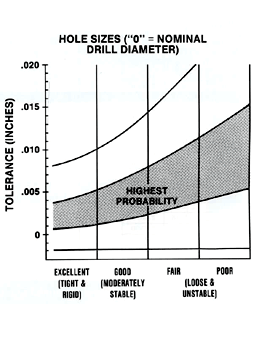Hole Size Tolerance
Rotabroach Cutters were originally designed as roughing tools to compete with twist drills and provide similar hole tolerance results. Many users have successfully applied Rotabroach Cutters to semi-finishing applications, reducing the number of passes from two or more to just one. A rigid machine tool and setup is required to produce holes to these specifications. Tolerances will vary with application and are impossible to pinpoint. Two hole tolerance probability curves are shown for dramatization, depicting typical results with a rigid machine tool and setup and a generalization of overall results from excellent to poor and unstable situations. Unstable conditions can lead to broken cutters.


1. If TiN coated tools are run too slowly, low friction effect allows the material to close-in.
2. Several titanium alloys and/or highly stressed materials exhibit a typical nature of closing-in on the cutter after the hole has been cut. In either case, corrective measures should be taken to eliminate the condition.
Please consult the Hougen Technical Sales Department.
 |

